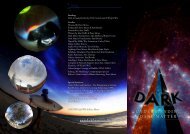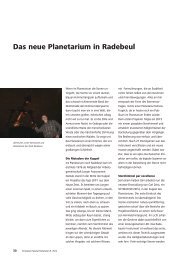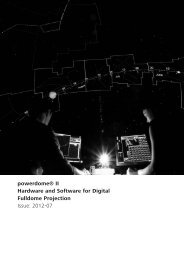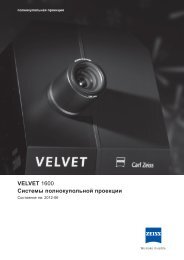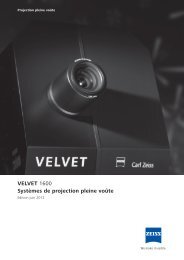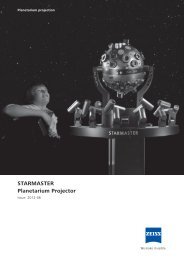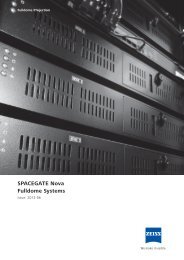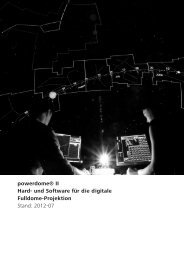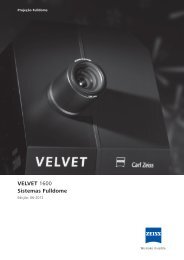Innovation Special Planetariums 9 - Carl Zeiss Planetariums
Innovation Special Planetariums 9 - Carl Zeiss Planetariums
Innovation Special Planetariums 9 - Carl Zeiss Planetariums
Create successful ePaper yourself
Turn your PDF publications into a flip-book with our unique Google optimized e-Paper software.
The new Planetarium in Radebeul<br />
Ulf Peschel, Head of Radebeul observatory<br />
and planetarium.<br />
30 <strong>Innovation</strong> <strong>Special</strong> <strong>Planetariums</strong> 9, 2012<br />
When the sun sets in the planetarium,<br />
slowly sparkling stars and the softly<br />
shimmering band of the Milky Way<br />
populate the dark blue sky, and the<br />
beholder is immersed in a world far<br />
away from the shrill and hectic routine<br />
of everyday life. It is the peace and quiet<br />
of a night in the mountains or in the<br />
endless expanse of a lonely desert, or<br />
the fairy-tale ambience of a Scandinavian<br />
forest. The planetarium shows us a<br />
sky that amazes and surprises us with its<br />
magnificent beauty.<br />
The Dome Matadors<br />
I first saw the Radebeul Planetarium<br />
from the inside in 1976 as a member<br />
of the Young Astronomers’ Working<br />
Group. At that time, at the center of the<br />
dome there was an ZKP 1 projector by<br />
<strong>Carl</strong> <strong>Zeiss</strong>. For us guys it was enormous<br />
fun when, unobserved, we could turn<br />
the daily cycle onto full speed, lean back<br />
in our seats, look up, and literally get<br />
butterflies in our stomachs. That went<br />
on until a little man in his mid-seventies<br />
came into the room, gave us a reprimanding<br />
look, and then got down to<br />
brass tacks, or, more accurately, to the<br />
stars in the sky of the evening in question.<br />
From this moment on we were<br />
totally spellbound and listened attentively<br />
to his every word, for he explained<br />
things with such devotion and such<br />
knowledge, with highly accurate wording<br />
that described the celestial bodies<br />
and their motions to the fullest possible<br />
extent. Everything about him perfectly<br />
matched a presentation about the stars,<br />
and nothing was reminiscent of today’s<br />
planetarium shows. I wonder whether<br />
today he would still find his public in<br />
the Planetarium. That first projector was<br />
followed by a ZKP 2 with a reasonable<br />
night sky and significantly expanded<br />
representation options compared to<br />
its predecessor. Operation was simple<br />
and clear. After 27 years of service, the<br />
instrument was literally worn out, and<br />
a new one had to be acquired. It was<br />
clear that the replacement should be<br />
an opto-mechanical projector, as digital<br />
systems are unsatisfactory, especially<br />
when it comes to star representations.<br />
Night sky par excellence<br />
For the last six months, a SKYMASTER<br />
ZKP 4, the latest development from <strong>Carl</strong><br />
<strong>Zeiss</strong>, has been operating in the dome of<br />
the planetarium. The first impression of<br />
the sky dome is overwhelming. The stars<br />
appear to be small points, sharply imaged<br />
over all areas of the projection surface<br />
onto a jet-black background. The<br />
celestial bodies get their light only from<br />
a high performance LED. The instrument<br />
at Radebeul is the first worldwide<br />
to be equipped with this technology.<br />
The brightness gradations are very fine.<br />
Many important stars are shown in their<br />
natural colors. What is very pleasant<br />
is that the colors can be clearly identi-




